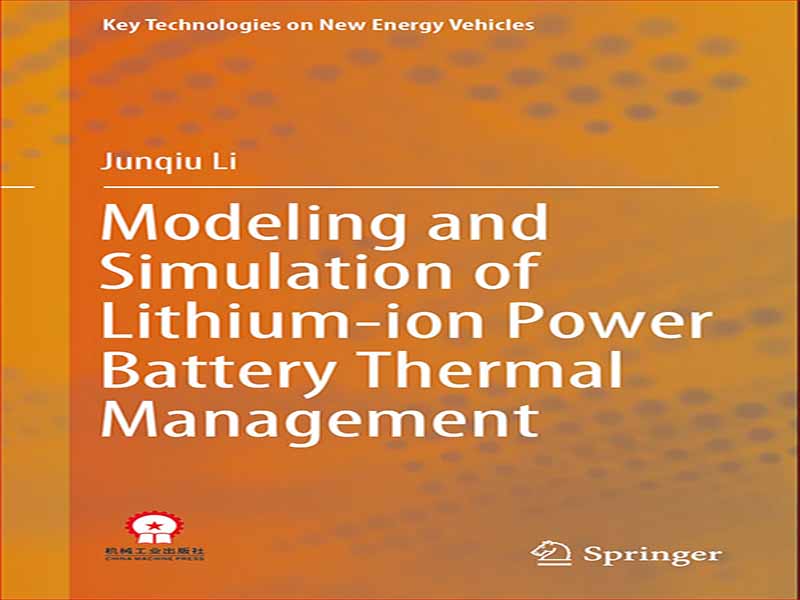- عنوان کتاب: Modeling and Simulation of Lithium-Ion Power Battery Thermal Management
- نویسنده: Junqiu Li
- حوزه: باتری
- سال انتشار: 2022
- تعداد صفحه: 343
- زبان اصلی: انگلیسی
- نوع فایل: pdf
- حجم فایل: 14.27 مگابایت
امروزه، جهان همچنان به شدت به سوخت های فسیلی مانند نفت و زغال سنگ برای رفع نیازهای انرژی خود متکی است. تحت فشار مشکلات فزاینده جدی زیست محیطی، تغییر در ساختار انرژی به یک روند اجتناب ناپذیر تبدیل شده است. توسعه وسایل نقلیه با انرژی کارآمد و انرژی جدید بخش مهمی از این روند است و به یک اجماع بزرگ در مورد توسعه طولانی مدت خودرو تبدیل شده است. تحت هدایت فعال سیاست های ملی، بازار خودروهای انرژی جدید چین به سرعت توسعه یافته است، با نرخ نفوذ بازار از 0.3 درصد در سال 2011 به بیش از 4 درصد در سال 2018. بر اساس هدف پیشنهادی در برنامه توسعه صنعت خودروهای انرژی نو (2021) –2035)، حجم فروش وسایل نقلیه جدید انرژی تا سال 2025 حدود 25 درصد خواهد بود. باتری برق منبع مهم انرژی برای وسایل نقلیه جدید انرژی است و عملکرد کارآمد و پایدار آن کلید اطمینان از عملکرد وسایل نقلیه جدید انرژی است. با مزایای چگالی انرژی بالا، چگالی توان بالا و عمر چرخه طولانی، باتری های لیتیوم یون در حال حاضر اولین انتخاب برای باتری های برق خودرو هستند. با این حال، از آنجایی که محدوده دمای کاری مناسب باتریهای لیتیوم یونی نسبتاً باریک است (معمولاً 10 تا 30 درجه سانتیگراد)، در حالی که محدوده دمایی وسایل نقلیه انرژی جدید در سناریوهای کاربردی بسیار گستردهتر است، الزامات برای سازگاری باتریهای قدرت با بالا – و محیط های با دمای پایین نیز با محبوبیت گسترده وسایل نقلیه انرژی جدید، خواستارتر هستند. برای حل تضاد بین مشخصات دمای باتری و الزامات کاربردی، مدیریت حرارتی باتری به وظایفی مانند اتلاف گرما، گرمایش و کنترل اختلاف دما نیاز دارد.
Nowadays, theworld is still relying heavily on fossil fuels such as oil and coal to meet its energy needs. Under the pressure of increasingly serious environmental problems, the change in energy structure has become an inevitable trend. The development of energy-efficient and new energy vehicles is an important part of this trend and has become a major consensus on the long-term development of automobiles. Under the active guidance of national policies, China’s new energy vehicle market has developed rapidly, with the market penetration rate growing from 0.3% in 2011 to over 4% in 2018. According to the goal proposed in the New Energy Vehicle Industry Development Plan (2021–2035), the sales volume of new energy vehicles will account for about 25% by 2025. Power battery is an important source of energy for newenergy vehicles, and its efficient and stable operation is the key to ensure the performance of newenergy vehicles. With the advantages of high energy density, high power density and long cycle life, lithium-ion batteries are currently the first choice for automotive power batteries. However, since the suitable working temperature range of lithium-ion batteries is relatively narrow (usually 10–30 °C), while the temperature range of new energy vehicles in application scenarios is much wider, the requirements for the adaptability of power batteries to high- and low-temperature environments are also more demanding with the widespread popularity of new energy vehicles. To solve the conflict between battery temperature characteristics and application requirements, battery thermal management requires tasks such as heat dissipation, heating and temperature difference control.
این کتاب را میتوانید از لینک زیر بصورت رایگان دانلود کنید:
Download: Modeling and Simulation of Lithium-Ion Power Battery Thermal Management



































نظرات کاربران